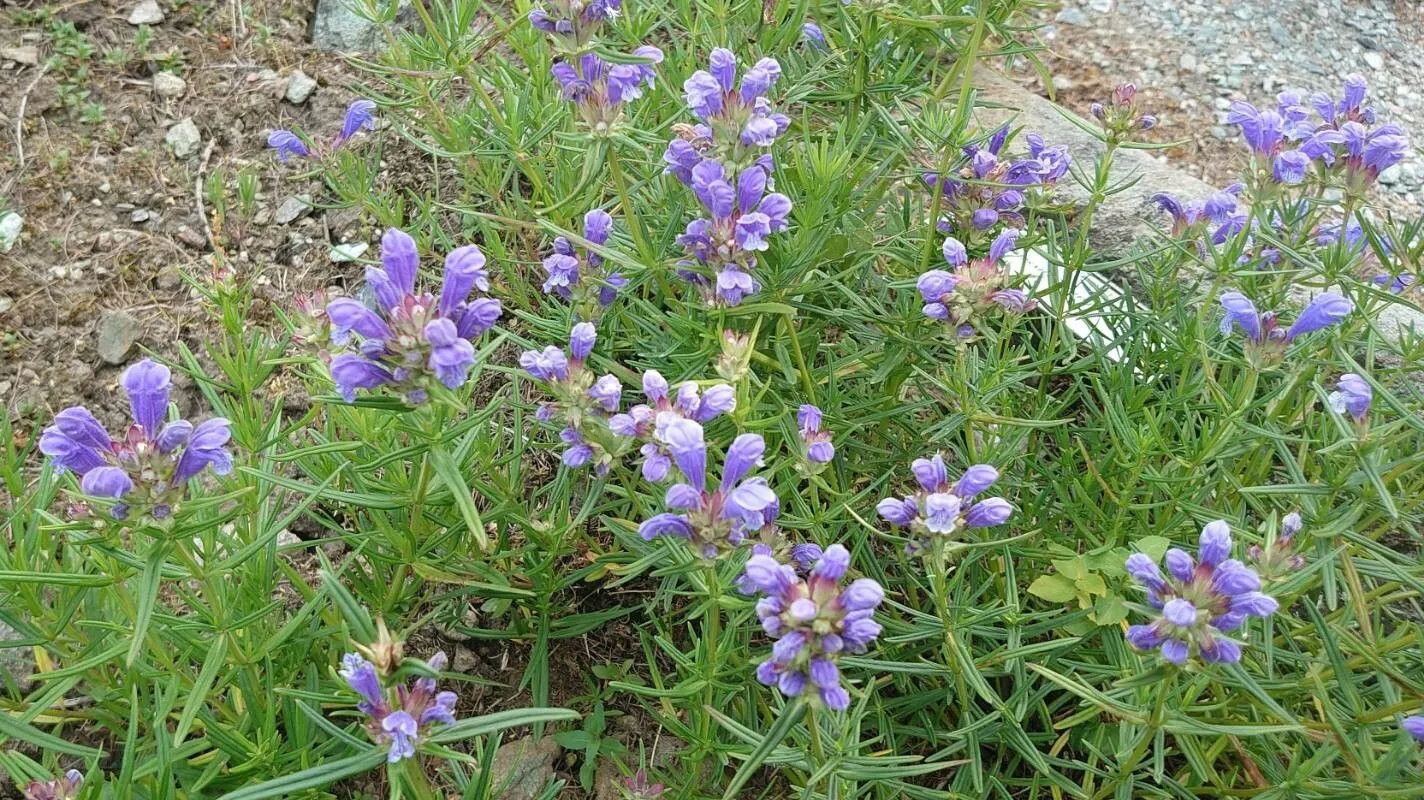
Author: L.
Bibliography: Sp. pl. 2:595. 1753
Year: 1753
Status: accepted
Rank: species
Genus: Dracocephalum
Vegetable: False
Observations: Europe to Mongolia
Drakblomma, scientifically known as Dracocephalum ruyschiana, is a captivating plant that belongs to the Lamiaceae family. This perennial herb has a wide geographical range, thriving in regions stretching from Europe to Mongolia. Known for its vibrant and striking appearance, Drakblomma has long been appreciated both for its beauty and its resilience in diverse climates.
The plant features lanceolate leaves and striking, bilabiate flowers that often come in shades of blue to purple. These flowers, arranged in opposite pairs along the stem, contribute to its dramatic and enchanting look, which is suggested by its name—Dracocephalum, meaning “dragon’s head” in Greek. This name is a fitting descriptor given the bold and spirited appearance of the plant’s blooms.
Drakblomma is typically found in sunny meadows, rocky slopes, and steppes, where it thrives in well-drained soil and open environments. It is a hardy species, capable of withstanding a range of environmental conditions, from the temperate zones of Europe to the more extreme climates of Mongolia.
First classified by the renowned botanist Carl Linnaeus and referenced in his seminal work “Species Plantarum” published in 1753, the scientific importance of Dracocephalum ruyschiana has been recognized for centuries. Linnaeus’s description laid the foundation for further botanical studies, and the plant continues to be a subject of interest for botanists and horticulturists alike.
Beyond its aesthetic appeal, Drakblomma is also noted for its medicinal uses. In traditional practices, it has been used to treat a variety of ailments, reflecting the plant’s historical significance in herbal medicine.
Whether admired in a natural habitat or cultivated in a garden, Drakblomma captivates observers with its beauty and adaptability, standing as a symbol of the rich biodiversity found across its broad natural range. The ongoing interest in this plant underscores its lasting appeal and the timeless beauty of its dragon-like flowers.
Dan: almindelig dragehoved
Deu: nordischer drachenkopf
Lav: ruiša pukgalve
Nob: dragehode
Swe: drakblomma, isoampiaisyrtti, svensk drakblomma
Nno: drakehovud
Fin: isoampiaisyrtti
En: Drakblomma, Nordischer Drachenkopf, Northern Dragonhead
Ar: بيقران الجبل
Hy: Վիշապագլուխ Ռուշի
Az: Ruyş ilanbaşı
Be: Змеегалоўнік Руйша
Zh: 青兰
Da: Almindelig dragehoved
Nl: Noorse Drakenkop
Et: Sile tondipea
Fi: Isoampiaisyrtti
Fr: Dracocéphale de Ruysch, Tête-de-dragon de Ruysch
De: Nordischer Drachenkopf
Hu: Északi sárkányfű
It: Melissa di Ruysch
Lv: Ruiša pukgalve
Lt: Miškinė žiomenė
No: Dragehode
Nb: Dragehode
Nn: Drakehovud
Pl: Pszczelnik wąskolistny
Ru: Змееголовник Рюйша
Sv: Drakblomma, Isoampiaisyrtti, Svensk drakblomma
Uk: Змієголовник Рюйша
© copyright of the Board of Trustees of the Royal Botanic Gardens, Kew.
Taken Jul 7, 2015 by Tela Botanica − Marie PORTAS (cc-by-sa)
Taken Jun 30, 2014 by Tela Botanica − Louise Boulangeat (cc-by-sa)
Taken Jun 19, 2022 by Manuëlle (cc-by-sa)
Taken May 28, 2022 by manuseitz (cc-by-sa)
Taken Jul 19, 2014 by Tela Botanica − Yoan MARTIN (cc-by-sa)
Taken Aug 8, 2022 by Baptiste Terrier (cc-by-sa)
Taken Jul 12, 2012 by Tela Botanica − Yoan MARTIN (cc-by-sa)
Taken Jul 19, 2014 by Tela Botanica − Yoan MARTIN (cc-by-sa)
Taken Jul 19, 2014 by Tela Botanica − Yoan MARTIN (cc-by-sa)
Taken Jun 28, 2021 by Maud Haering (cc-by-sa)
Taken Jul 19, 2014 by Tela Botanica − Yoan MARTIN (cc-by-sa)
Taken Jul 2, 1999 by Tela Botanica − Liliane Roubaudi (cc-by-sa)
Taken Jul 2, 1999 by Tela Botanica − Liliane Roubaudi (cc-by-sa)
Taken Jul 6, 2015 by Tela Botanica − Yoan MARTIN (cc-by-sa)
Taken Jun 30, 2014 by Tela Botanica − Louise Boulangeat (cc-by-sa)
Taken Jun 6, 2022 by Alyona Appel (cc-by-sa)
Taken Jan 1, 1970 by Photoflora – L’Abbé COSTE (©)
Taken Jul 15, 2005 by Photoflora – Benoit BOCK (©)
Taken Jul 15, 2005 by Photoflora – Benoit BOCK (©)
Taken Jul 2, 1999 by Tela Botanica − Liliane Roubaudi (cc-by-sa)
Taken Jul 15, 2005 by Photoflora – Benoit BOCK (©)
Taken Jan 1, 1800 by Tela Botanica − Thierry Pernot (cc-by-sa)
Taken Jul 6, 2015 by Tela Botanica − Yoan MARTIN (cc-by-sa)
Taken Jul 15, 2005 by Photoflora – Benoit BOCK (©)
Taken Jan 1, 1800 by Tela Botanica − Thierry Pernot (cc-by-sa)
Ph maximum: 7.5
Ph minimum: 7.0
Light: 6
Atmospheric humidity: 5
Bloom months: [‘jun’, ‘jul’, ‘aug’, ‘sep’]
Soil nutriments: 2
Family: Myrtaceae Author: (F.Muell.) K.D.Hill & L.A.S.Johnson Bibliography: Telopea 6: 402 (1995) Year: 1995 Status:…
Family: Rubiaceae Author: Pierre ex A.Froehner Bibliography: Notizbl. Bot. Gart. Berlin-Dahlem 1: 237 (1897) Year:…
Family: Sapindaceae Author: Koidz. Bibliography: J. Coll. Sci. Imp. Univ. Tokyo 32(1): 38 (1911) Year:…
Family: Asteraceae Author: A.Gray Bibliography: Pacif. Railr. Rep.: 107 (1857) Year: 1857 Status: accepted Rank:…
Family: Fabaceae Author: Medik. Bibliography: Vorles. Churpfälz. Phys.-Ökon. Ges. 2: 398 (1787) Year: 1787 Status:…
Family: Aspleniaceae Author: (Cav.) Alston Bibliography: Bull. Misc. Inform. Kew 1932: 309 (1932) Year: 1932…